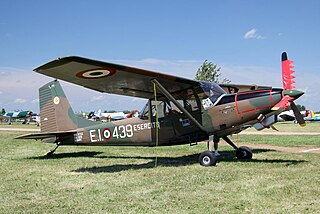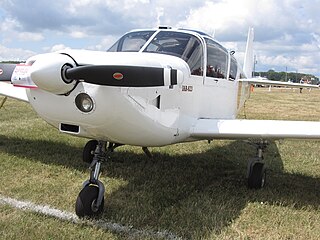Related Research Articles
The IAR-825 Triumf is a Romanian-designed tandem multirole trainer aircraft based on the IAR-823 built for the Romanian Air Force. The aircraft is roughly in the same class with the Brazilian EMBRAER Tucano. The IAR-825 is equipped with the Canadian Pratt & Whitney Canada PT6 turboprop engine. The type's first flight took place on the 12 June 1982.

The IAR 79 was a twin-engine bomber and military reconnaissance aircraft with a wood and metal structure that saw service in World War II built under licence in Brasov, Romania, by Industria Aeronautică Română
The IAR 14 is a Romanian low-wing monoplane fighter-trainer aircraft designed before World War II.

The IAR 316 is a Romanian license-built Aérospatiale SA 316B Alouette III manufactured by Industria Aeronautică Română (IAR).

The Cessna 441 Conquest II is the first turboprop powered aircraft designed by Cessna, and was meant to fill the gap between their jets and piston-engined aircraft. It was developed in November 1974, with the first aircraft delivered in September 1977. It is a pressurized, 8–9 passenger turbine development of the Cessna 404 Titan.

PZL.46 Sum (sheatfish) was a light bomber of the Polish Air Force before World War II, which, was directed to serial production in the spring of 1939. These planes were in production, but the Polish industry did not manage to produce them before the outbreak of the war.

The Savoia-Marchetti SM.62 was an Italian single-engine maritime patrol flying boat produced from 1926. It served with the Regia Aeronautica and with a number of foreign users, and was licence-produced in Spain and the Soviet Union. Some of the Spanish aircraft were still in service during the Spanish Civil War

The SET 7 was a military trainer and reconnaissance aircraft that was produced in Romania in the mid-1930s. It was originally designed as a conventional single-bay biplane, with slightly staggered wings, a standard undercarriage with fixed tailskid, and a tandem open-cockpit arrangement for the pilot and instructor or observer. Power was supplied by an Armstrong Siddeley Jaguar radial engine, and from the outset the aircraft was equipped for wireless and photographic reconnaissance duties.
The SET XV was a fighter aircraft developed in Romania in the mid-1930s. It was a conventional single-bay biplane with staggered wings of unequal span braced by N-struts. It was fitted with fixed tailwheel undercarriage with spatted mainwheels. The cockpit was fully enclosed, and the engine was fitted with a NACA cowl. Construction throughout was fabric-covered metal.

The SIAI-Marchetti SM.1019 is an Italian STOL liaison monoplane built by SIAI-Marchetti for the Italian Army, and based on the Cessna O-1 Bird Dog.
The IAR-822 was an agricultural aircraft built in Romania in the 1960s. Based on the IAR-821, it was a conventional low-wing monoplane with fixed, tailwheel undercarriage and differed from its predecessor mainly in the choice of a horizontally opposed engine in place of a radial.

The IAR-823 is a civil and military trainer aircraft built in Romania from 1974 until 1983. It is a conventional low-wing monoplane with retractable tricycle undercarriage. The pilot and instructor sit side-by-side, and two more seats can be fitted behind them. The type was adopted by the Romanian Air Force as a primary trainer, and was also supplied to Romanian and Hungarian aeroclubs and the national flying school of Angola.

The IAR-827 was an agricultural aircraft built in Romania in the 1970s and 1980s. The penultimate member of the family of designs that began with the IAR-821, it was, like the others, a conventional low-wing monoplane with fixed, tailwheel undercarriage, and shared the all-metal construction of the IAR-826. The prototype flew in 1976, powered by a Lycoming IO-720 engine, but the production examples that followed all had the PZL-3S.

The IAR-22 was a single engine basic trainer built in Romania in about 1934. It was a low-wing monoplane with two seats in tandem and a fixed conventional undercarriage.

The IAR 27 was a 1930s Romanian two-seat low-wing monoplane primary trainer designed and built by Industria Aeronautică Română.
The Aerostar AG-6 was a prototype Romanian agricultural aircraft of the late 1980s, developed for IAv, of Bacău. The company was later known as Aerostar.
The IAR-818 was a Romanian multipurpose aircraft based on the IAR-817. It was developed by IAR in both landplane and floatplane forms.
The IAR-817 was a Romanian multipurpose aircraft built in the 1950s.
The IAR-811 was a Romanian trainer aircraft built in the late 1940s. It was the first aircraft designed and built in Romania following the end of the Second World War.
The IAR-814, aka MR-2, was a Romanian designed and built twin-engined trainer aircraft built in the early 1950s, the first twin-eninged aircraft wholly designed and built in Romania.
References
- ↑ "IAR-831 PelicanICA - IR31 L1P L". Doc8643. Retrieved 2 March 2019.
| | This article on an aircraft of the 1980s is a stub. You can help Wikipedia by expanding it. |